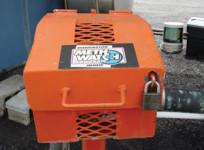Using Locks To Secure Your Retail Operation

Although there may be more expensive and elaborate ways to guard a retail outlet against potential thieves and vandals, one of the most effective is by using locks. According to J. Billy Pirkle, director of Environmental, Health & Safety for Agrium Retail, Collinsville, IL, locks can serve as an effective crime deterrent.
“Basically, any lock is designed to keep something secure from unwanted access,” says Pirkle. “Considering all the places at a retail facility that need to be protected, locks are an important tool in preventing unauthorized access from taking place.”
To determine where locks will do the most good at an outlet, Pirkle recommends retailers conduct a vulnerability assessment. In this installment of “Dealership Security and You,” we review the places where retailers should consider placing locks.
1. Place Locks On All Facility Entrances
Obviously, says Pirkle, the first place retailers should put locks is at the front gates. “No matter where you are located, it is always a good idea to have a lock on the front fence or gate so that vehicles can’t get onto the outlet grounds when it is closed,” he says.
In this location, locks can take several different forms — everything from a chain lock to a heavy-duty padlock will do, as long as it can be secured and restricts access.
To make certain that these locks are maintained in top working order, Pirkle recommends retailers inspect them for damage or wear each morning when opening the facility. They can also have some kind of weatherproof epoxy applied for added protection.
2. Facility Doors and Warehouses Need To Be Locked
Besides front gates and fences, retailers almost universally have locks installed on their main building and warehouse doors. These should be heavy-duty metal construction and include a 1.5-inch throw or an added steel plate to prevent them from being pried open with a crowbar.
“Considering the important papers and potentially dangerous materials that are kept in these locations, you wouldn’t want to be without some kind of security lock here,” he says.
With these locks, retailers should restrict the number of keys used to an absolute minimum.
3. Valves On NH3 Tanks Need Locks
Of course, one of the most important places at an outlet for locks is the anhydrous ammonia (NH3) storage tanks. According to Bill Garver, Jr., plant manager for Brandt Consolidated, Ashland, IL, these locks should be made of durable carbon steel, making them difficult to cut with bolt cutters. “Keys for these locks should be restricted to only a few trusted employees,” says Garver. “In fact, the existing keys should be marked ‘do not duplicate’ to make certain no one makes illegal copies of them.”
These locks should be checked for tampering every time a valve is accessed, or at least once per month during slower times of the year.
4. Consider Other Places That Could Use Locks
At some facilities, retailers have begun adding some kind of locks to their nurse tanks. In other instances, protecting a water access junction might make sense.
“We have our main water pipe enclosed inside a locked storage shed,” says Ted Deerkop, area manager for The McGregor Co., Garfield, WA. “There may not be a water theft problem in our area as there can be for NH3, but that doesn’t mean someone wouldn’t tear something like that up if we didn’t take steps to protect it.”






